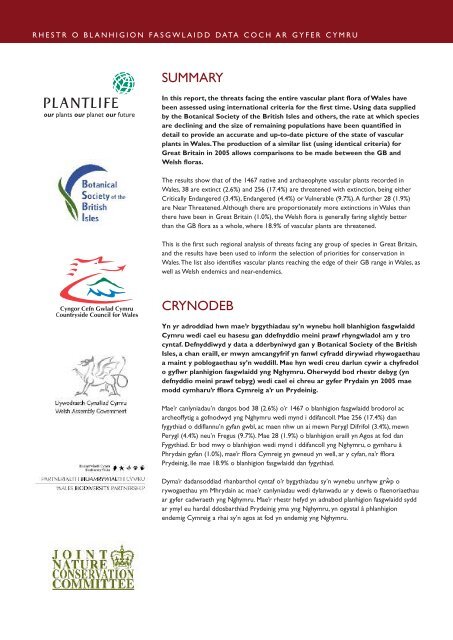A Vascular Plant Red Data List for Wales - Plantlife
A Vascular Plant Red Data List for Wales - Plantlife
A Vascular Plant Red Data List for Wales - Plantlife
You also want an ePaper? Increase the reach of your titles
YUMPU automatically turns print PDFs into web optimized ePapers that Google loves.
R H E S T R O B L A N H I G I O N F A S G W L A I D D D ATA C O C H A R G Y F E R C Y M R USUMMARYIn this report, the threats facing the entire vascular plant flora of <strong>Wales</strong> havebeen assessed using international criteria <strong>for</strong> the first time. Using data suppliedby the Botanical Society of the British Isles and others, the rate at which speciesare declining and the size of remaining populations have been quantified indetail to provide an accurate and up-to-date picture of the state of vascularplants in <strong>Wales</strong>.The production of a similar list (using identical criteria) <strong>for</strong>Great Britain in 2005 allows comparisons to be made between the GB andWelsh floras.The results show that of the 1467 native and archaeophyte vascular plants recorded in<strong>Wales</strong>, 38 are extinct (2.6%) and 256 (17.4%) are threatened with extinction, being eitherCritically Endangered (3.4%), Endangered (4.4%) or Vulnerable (9.7%).A further 28 (1.9%)are Near Threatened.Although there are proportionately more extinctions in <strong>Wales</strong> thanthere have been in Great Britain (1.0%), the Welsh flora is generally faring slightly betterthan the GB flora as a whole, where 18.9% of vascular plants are threatened.This is the first such regional analysis of threats facing any group of species in Great Britain,and the results have been used to in<strong>for</strong>m the selection of priorities <strong>for</strong> conservation in<strong>Wales</strong>.The list also identifies vascular plants reaching the edge of their GB range in <strong>Wales</strong>, aswell as Welsh endemics and near-endemics.CRYNODEBYn yr adroddiad hwn mae’r bygythiadau sy’n wynebu holl blanhigion fasgwlaiddCymru wedi cael eu hasesu gan ddefnyddio meini prawf rhyngwladol am y trocyntaf. Defnyddiwyd y data a dderbyniwyd gan y Botanical Society of the BritishIsles, a chan eraill, er mwyn amcangyfrif yn fanwl cyfradd dirywiad rhywogaethaua maint y poblogaethau sy’n weddill. Mae hyn wedi creu darlun cywir a chyfredolo gyflwr planhigion fasgwlaidd yng Nghymru. Oherwydd bod rhestr debyg (yndefnyddio meini prawf tebyg) wedi cael ei chreu ar gyfer Prydain yn 2005 maemodd cymharu’r fflora Cymreig a’r un Prydeinig.Mae’r canlyniadau’n dangos bod 38 (2.6%) o’r 1467 o blanhigion fasgwlaidd brodorol acarcheoffytig a gofnodwyd yng Nghymru wedi mynd i ddifancoll. Mae 256 (17.4%) danfygythiad o ddiflannu’n gyfan gwbl, ac maen nhw un ai mewn Perygl Difrifol (3.4%), mewnPerygl (4.4%) neu’n Fregus (9.7%). Mae 28 (1.9%) o blanhigion eraill yn Agos at fod danFygythiad. Er bod mwy o blanhigion wedi mynd i ddifancoll yng Nghymru, o gymharu âPhrydain gyfan (1.0%), mae’r fflora Cymreig yn gwneud yn well, ar y cyfan, na’r ffloraPrydeinig, lle mae 18.9% o blanhigion fasgwlaidd dan fygythiad.Dyma’r dadansoddiad rhanbarthol cyntaf o’r bygythiadau sy’n wynebu unrhyw grw^ p orywogaethau ym Mhrydain ac mae’r canlyniadau wedi dylanwadu ar y dewis o flaenoriaethauar gyfer cadwraeth yng Nghymru. Mae’r rhestr hefyd yn adnabod planhigion fasgwlaidd syddar ymyl eu hardal ddosbarthiad Prydeinig yma yng Nghymru, yn ogystal â phlanhigionendemig Cymreig a rhai sy’n agos at fod yn endemig yng Nghymru.
















